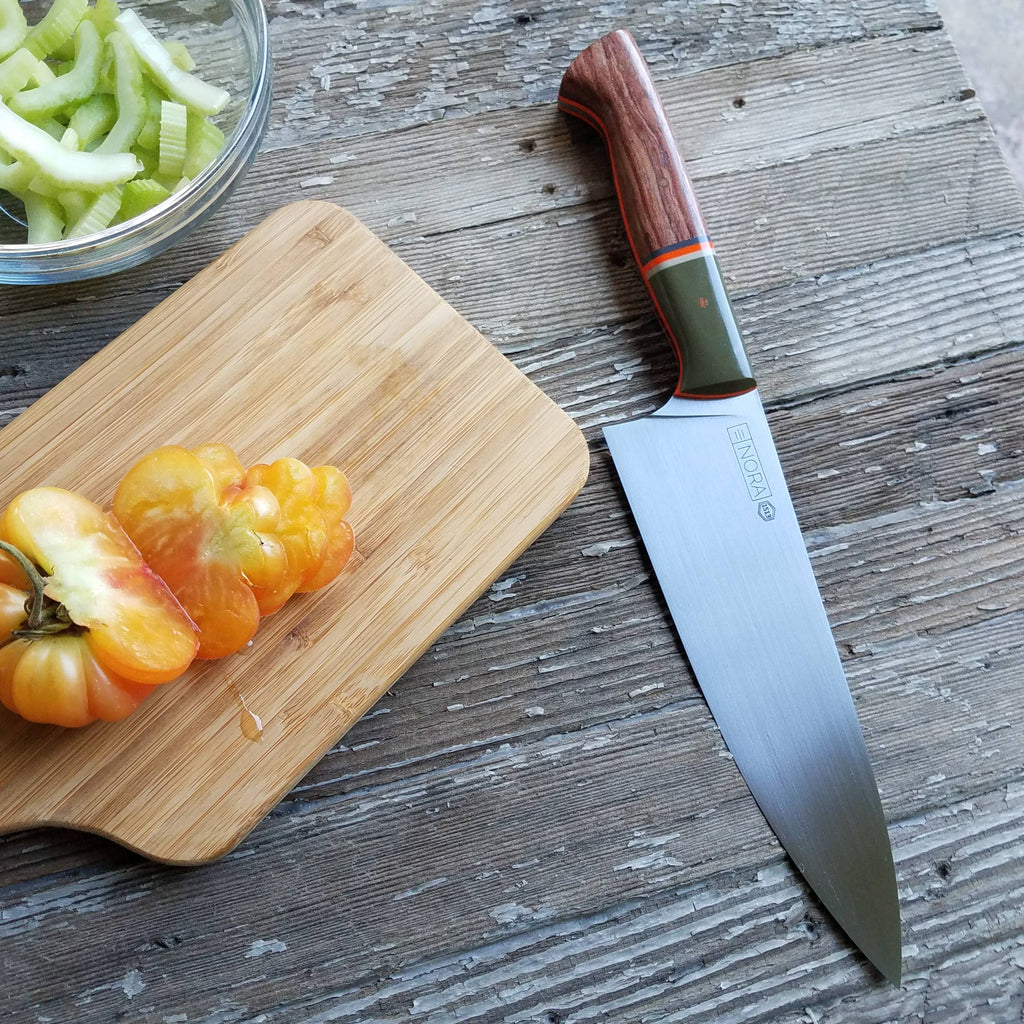
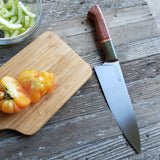
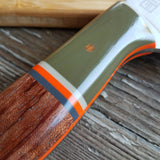

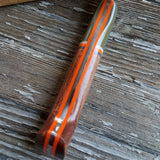
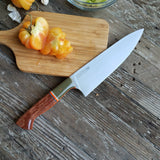
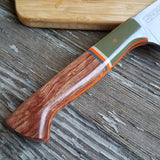

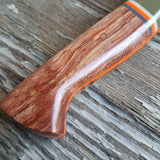

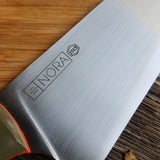
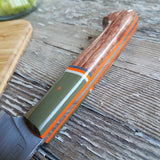
NORA #1513 - 7.5" Chef - 01 Carbon Steel - LASER - Camo Green & Bubinga
$ 409.00
PLEASE BE AWARE - THIS IS A CARBON STEEL KNIFE. THIS IS NOT A STAINLESS STEEL KNIFE. A CARBON STEEL KNIFE WILL FORM A PATINA ON THE KNIFE AND IS PRONE TO RUST IF NOT CARED FOR PROPERLY.
KNIFE HIGHLIGHTS
- Blade Type: Chef Knife
- Blade Length: 7.5 Inches
- Total Length: 13 Inches
- Handle Style: Western | Right or Left Hand Use
- Steel: O1 Carbon Steel
- Rockwell Hardness: 61 HRC
- Grind Type: Laser (very thin, you can read more below)
- Weight: .54 lbs.
- Handle Materials: Stabilized Bubinga Wood, Natural Micarta Pins, OD Green G10 upper, Charcoal gray, tan & orange G10 used as accents, orange liners
- This Blade is Ground...
- >>>Thin for Performance (Great Performance but somewhat delicate)
- Thick for Durability (tough, built to last for heavy wear-n-tear)
- Mid-Range with Special Geometry (specially ground for food release and glide but blade is kept slightly thicker for durability)
- This Knife Feels...
- Heavy in Hand (hefty, durable)
- Light (nimble, maneuverable)
- >>> Not too heavy, not too light (Switzerland)
GENERAL USES OF THIS KNIFE
CHEF KNIFE
Our take on the classic Chef knife. This is an extremely versatile knife that is a jack-of-all-trades worker and one of the single most important knives in a kitchen. Our Chef knife design can easily accommodate both a pinch grip and a full hold. It is a good choice for those with larger hands or those who prefer a full hold on the handle. Our design is also excellent for those who like a rocking motion while cutting.
GRIND
We would categorize this knife's grind as a laser. A "laser" knife in our industry typically refers to a knife that is ground very thin both at the spine and behind the edge. Because there is very little resistance, these knives will easily cut and this holds true even when they are not at full sharpness. Performance is excellent which is way some people swear by them.
Lasers tend to be lighter in weight than most other chef knives and they occasionally have more flex. The tradeoff with a laser is that they tend to be more delicate so you need to take care to not use the knife on any excessively hard objects or bones or the blade is likely to chip.
STEEL INFORMATION:
01 Carbon Steel
The blade on this knife is composed of a high carbon O1 tool steel with a hand-sanded, satin finish. O1 tool steel is a great all around choice for carbon steel as it is easily sharpened and the fine grain structure produces a very sharp edge. It is also an economical alternative to some of the more expensive Japanese carbon steels while offering similar benefits and a more hardy steel. HRC hardness on this knife comes in at a solid 61.
As this is a carbon steel, the blade will form a slight patina over time. This is normal and actually the mark of a beautifully used knife. Please note, however, that a carbon steel knife does require more maintenance than its stainless steel counterpart, mainly that it must be washed or wiped clean shortly after each use to prevent unwanted rust or stains.
HANDLE DESIGN & MATERIALS:
Every one of our knives is handmade, numbered and unique. The number on each knife represents the production order our small company. As such, if you have NORA #1000, that knife represents the 1,000th knife made here at NORA knives.
This NORA knife has been handled with a mix of materials including stabilized African Bubinga wood, which has a beautiful reddish-brown hue, and ultra-durable G10. The main G10 used on this handle is the OD green upper. Next to this upper bolster piece there are three stripes of G10 in charcoal gray, hunter orange and tan. We love how the orange accents on this knife give it just a small pop of color on this otherwise neutral design scheme.
Wood stabilization is an added feature that we offer with our knives. Wood that is stabilized has been injected with a clear acrylic resin under a vacuum process. Stabilization helps to minimize, if not eliminate, any cracking, warping, shrinkage and/or expanding of the material. Stabilized wood will not absorb water and is generally impervious to oils. The process helps to ensure your knife has a long lifespan in the kitchen.
